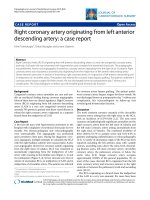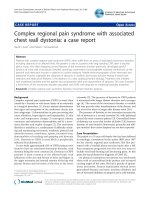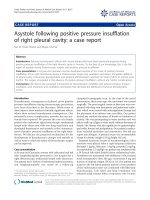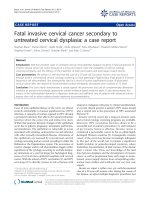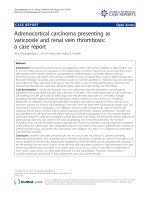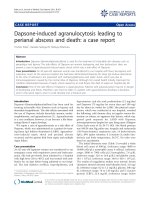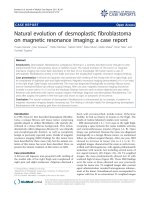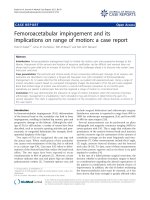Báo cáo y học: "Severe heparin-induced thrombocytopenia: when the obvious is not obvious, a case report" pptx
Bạn đang xem bản rút gọn của tài liệu. Xem và tải ngay bản đầy đủ của tài liệu tại đây (427.29 KB, 5 trang )
BioMed Central
Page 1 of 5
(page number not for citation purposes)
Journal of Medical Case Reports
Open Access
Case report
Severe heparin-induced thrombocytopenia: when the obvious is not
obvious, a case report
Graham M Cormack and Larry J Kaufman*
Address: Department of Medicine, University of Hawaii, and St. Francis Medical Center, Honolulu, HI, USA
Email: Graham M Cormack - ; Larry J Kaufman* -
* Corresponding author
Abstract
Thrombocytopenia commonly occurs in hospitalized patients, particularly critically ill patients. We
present an exemplifying case of severe heparin-induced thrombocytopenia (HIT) in an effort to
solidify its high priority in the differential diagnosis of thrombocytopenia. A 75-year-old female
underwent cardiac surgery with intraaortic balloon pump (IABP) placement. A platelet count drop
to 25 × 10(9)/L by the third postoperative day was attributed to the IABP, which was removed.
Her thrombocytopenia remained refractory to multiple platelet transfusions over several days.
Right hand cyanosis then developed, attributed to a right radial arterial catheter, which was
removed. All toes and fingers then showed severe ischemic changes. Ten days after the initial
platelet count drop, a critical care specialist new to the treating team suspected HIT. Heparin
exposure was stopped and argatroban was initiated. A HIT antibody test was subsequently strongly
positive. The patients thrombocytopenia gradually resolved. No additional thromboses occurred
during a 27-day intensive care unit stay. This case underscores the need for vigilance in suspecting
HIT in patients with thrombocytopenia and recent heparin exposure. To avoid catastrophic
outcomes in such patients, heparin should be stopped and alternative anticoagulation should be
initiated, at least until HIT is excluded.
Background
Thrombocytopenia is a common finding in hospitalized
patients, particularly critically ill patients, with readily
plausible causes including disseminated intravascular
coagulation, dilution from blood transfusions, continu-
ous venovenous hemodialysis (CVVHD), liver disease
with hypersplenism, and certain medications. Physicians
should be vigilant in excluding the more dangerous causes
of thrombocytopenia. For example, heparin-induced
thrombocytopenia (HIT) warrants serious consideration
because it is a potentially devastating, yet underdiag-
nosed, complication of one of the most commonly pre-
scribed medications worldwide.
Approximately one trillion units of heparin are adminis-
tered to 12 million patients per year in the United States
[1]. HIT is caused by antibodies to a complex of heparin
and platelet factor 4 that activate platelets, resulting in
release of procoagulant microparticles, thrombocytope-
nia, excessive thrombin generation, and frequently
thrombosis [2]. HIT occurs in approximately 0.5% of
patients with occult exposure to heparin (e.g., catheter
flushes), 0.1%–1% of patients treated with low-molecu-
lar-weight heparin [3], and 3%–5% of patients receiving
unfractionated heparin [4]. Although these are small per-
centages, the ubiquitous use of heparin puts an extremely
large number of patients at risk.
Published: 30 April 2007
Journal of Medical Case Reports 2007, 1:13 doi:10.1186/1752-1947-1-13
Received: 18 December 2006
Accepted: 30 April 2007
This article is available from: />© 2007 Cormack and Kaufman; licensee BioMed Central Ltd.
This is an Open Access article distributed under the terms of the Creative Commons Attribution License ( />),
which permits unrestricted use, distribution, and reproduction in any medium, provided the original work is properly cited.
Journal of Medical Case Reports 2007, 1:13 />Page 2 of 5
(page number not for citation purposes)
We present a case of severe HIT complicated by a highly
hypercoagulable state, in which heparin exposure was
inconspicuous and diagnosis was delayed. This case
underscores the need for vigilance in suspecting HIT in
any patient with thrombocytopenia and recent heparin
exposure.
Case report
A 75 year-old Hawaiian-Chinese female with a history of
aortic stenosis, chronic renal insufficiency, and hyperten-
sion presented to her cardiologist with pitting edema of
the bilateral lower extremities. On March 21
st
, 2005, a car-
diac catheterization showed an ejection fraction of 15%,
and severe aortic stenosis, aortic regurgitation, and mitral
regurgitation. During catheterization, the venous and
arterial sheaths were each flushed with approximately 250
units of heparin. Elective aortic valve replacement and
mitral valve repair surgery with intraaortic balloon pump
(IABP) placement was performed 10 days later. While on
cardiopulmonary bypass, she received 32,000 units of
heparin.
The patient's preoperative platelet count of 108 × 10
9
/L
fell to 25 × 10
9
/L by the third postoperative day. She was
transfused with 12 units of random donor platelets and
received norepinephrine for blood pressure support. The
decrease in platelets was attributed to the IABP, which
subsequently was removed. The patient bled from the
femoral insertion site and developed further hypotension.
She underwent surgical repair of the femoral artery, dur-
ing which she received 18 units of random donor plate-
lets, 8 units of packed red blood cells, and 4 units of fresh
frozen plasma. Her renal function deteriorated, necessitat-
ing CVVHD. A heparin-flushed dialysis catheter was
placed, and the patient was exposed to additional heparin
in the CVVHD tubing circuit.
Seven days postoperatively, the platelet count remained
low (43 × 10
9
/L) despite a cumulative transfusion total of
48 units of random donor platelets. Differential diagnos-
tic considerations by the patient's consultants included
accelerated platelet removal from the circulation owing to
CVVHD and sepsis-related disseminated intravascular
coagulation. Two days later, right hand cyanosis was
noted and attributed to the presence of a right radial arte-
rial catheter, which was removed the next day without
improvement. By then, all toes and fingers showed severe
ischemic changes (Figure 1). Two days later, the platelet
count reached its nadir (8 × 10
9
/L), resulting in more
platelet transfusions.
A Critical Care specialist joined the multi-physician team
the next day, and prompted by the ischemic physical find-
ings, ordered a heparin-platelet factor 4 enzyme-linked
immunosorbent assay (ELISA) which later proved
strongly positive. The direct thrombin inhibitor arga-
troban was immediately begun at the recommended start-
ing dose for patients without hepatic impairment (2 mcg/
kg/min) and titrated downward over the next few days
(lowest dose, 0.25 mcg/kg/min) because of activated par-
tial thromboplastin times (aPTTs) of up to 200 seconds
(baseline aPTT 35.1 seconds). Laboratory values sug-
gested fairly normal liver function (aspartate aminotrans-
ferase 32 IU/L, alanine aminotransferase 17 IU/L,
albumin 2.9 g/dL, total bilirubin 1.9 mg/dL). The pro-
nounced effect of argatroban was hypothesized to be due
to poor cardiac function and therefore poor hepatic per-
fusion.
Gastrointestinal bleeding occurred while aPTTs were
supratherapeutic, necessitating a 4-unit transfusion of
packed red blood cells and the temporary cessation of
argatroban. Upper and lower endoscopies showed only
diffuse oozing likely due to underlying coagulopathy.
Argatroban therapy was continued despite the gastrointes-
tinal bleeding, in view of the patient's current manifesta-
tions of, and future risk for thromboembolism. That risk
was underscored by ultrasound evidence of a free-floating
pedunculated thrombus in the right internal jugular vein.
On the sixth day of argatroban therapy, the platelet count
exceeded 100 × 10
9
/L. Warfarin was initiated at the
expected maintenance dose (1 mg/day). After the first
dose, however, her warfarin was held for two days because
of INR values ranging between 2.5 and 6.0. All subsequent
blood draws for PT/INR were done at least six hours after
temporary cessation of argatroban infusion, and an INR
goal between 2–3 was attained. Argatroban was discontin-
ued after five days of overlap.
During the remainder of her 27-day stay in intensive care,
the patient developed no additional thromboses. She
required bilateral mid-foot amputations and amputation
of all fingers of her right hand due to irreversible ischemic
gangrenous necrosis. Figure 2 summarizes the patient's
platelet counts and key clinical events during hospitaliza-
tion. She was ultimately discharged to a long-term reha-
bilitation facility, but later died after cardiac arrest. No
autopsy was obtained.
Discussion
Thrombocytopenia, a commonly encountered condition
in hospitalized patients, is often nothing more than a sta-
tistical laboratory variant or a benign hematologic state.
The appropriate treatment may be simple observation
with repeat measurement or withdrawal of an offending
medication (e.g., a sulfonamide). However, in a signifi-
cant number of cases, a low platelet count may herald a
severe condition, e.g., HIT. HIT has traditionally been
classified into two subtypes, based on pathophysiology.
Journal of Medical Case Reports 2007, 1:13 />Page 3 of 5
(page number not for citation purposes)
Type I is non-immune, usually of no clinical consequence,
requires no treatment, and usually resolves spontaneously
within days. Type II is an immune-mediated disorder with
often catastrophic results. The cornerstones of its treat-
ment are both discontinuation of all heparin (including
catheter flushes) and initiation of alternative anticoagula-
tion. Diagnosis is typically made on clinical grounds, with
laboratory tests (often with slow turnaround times) play-
ing a supportive role. Platelets usually decrease to either
50% of baseline or less than 150 × 10
9
/L. Assays for HIT
include the sensitive (>90%) but less specific (~71%)
heparin-platelet factor 4 ELISA which is often used as a
screening test, and the serotonin release assay (sensitivity
and specificity 100% and 97%, respectively) which can be
performed as a confirmatory test but is not universally
available and/or utilized [5]. The employment of a scor-
ing system which estimates pretest probability may help
guide clinical decision-making regarding the performance
and/or interpretation of these diagnostic tests [6].
Without prompt diagnosis and proper treatment, patients
with HIT complicated by thrombosis often experience dis-
mal outcomes, with limb amputation in approximately
10%, and death in about 20%–30% [7]. The currently
used classification scheme of two very different processes
with significantly divergent treatments and outcomes has
been partially responsible for the lack of awareness of HIT
type II. For that reason, the term "HIT" when used alone,
is now becoming reserved for use in referring to the
immune-mediated type, or type II [4].
In HIT, even when thrombocytopenia is severe, bleeding
is rare. Rather, patients with the greatest relative decrease
in platelet count have the greatest risk of thrombosis [8].
Just as our patient was obviously prone to thromboembo-
lism, so are approximately 50% of HIT patients, whose
initial presentations include either venous or arterial
thromboemboli [7]. Additionally, in HIT patients without
thrombosis at diagnosis, the risk for thrombosis in the
weeks after heparin cessation is 19%–52% [9-11]. This
risk persists even after platelet counts have returned to
normal, thus underscoring the need for long-term oral
anticoagulation.
Our patient, who developed thrombocytopenia resistant
to transfusion immediately after her open-heart surgery,
highlights two interesting aspects of the diagnosis and
presentation of HIT. First, there are often plausible alter-
native explanations in the critically ill patient with throm-
bocytopenia. In our patient, the decreased platelet count
was initially attributed to both cardiopulmonary bypass
and the presence of the intraaortic balloon pump. Later, it
was blamed on sepsis, CVVHD, and bleeding. And though
all of these devices and conditions are clearly associated
with thrombocytopenia, HIT was not considered in the
differential diagnosis despite the development of
ischemic phenomenon. Secondly, while thrombocytope-
nia in HIT classically occurs within 5 to 10 days after ini-
tiation of heparin, our patient exemplifies the increasingly
recognized rapid-onset presentation of HIT. This more
fulminant type of HIT may occur in up to 30% of patients
Gangrenous right hand and left foot as they appeared on hospital day #15Figure 1
Gangrenous right hand and left foot as they appeared on hospital day #15.
Journal of Medical Case Reports 2007, 1:13 />Page 4 of 5
(page number not for citation purposes)
diagnosed with HIT, whereby the thrombocytopenia
becomes apparent early, even within hours, after heparin
re-exposure [11].
When HIT with or without thrombosis is suspected, the
first step should be immediate cessation of all heparin,
including heparin flushes and low-molecular-weight
heparins. Alternative anticoagulation should be started
immediately (Seventh ACCP Conference on Antithrom-
botic and Thrombolytic Therapy Grade 1C+ recommen-
dation for lepirudin and Grade 1C recommendation for
argatroban) [11]. Heparin cessation alone is insufficient,
as patients remain in a prothrombotic state [9-11]. During
the design of multicenter trials of direct thrombin inhibi-
tion in HIT, institutional review boards and the Food and
Drug Administration deemed it unethical to have control
arms consisting only of heparin cessation [12].
In the United States, the only approved anticoagulants for
use in patients with HIT are the direct thrombin inhibitors
argatroban, which is hepatically metabolized, lepirudin,
which is renally cleared, and bivalirudin, which is only
approved for patients undergoing percutaneous coronary
intervention. Our patient was treated with argatroban,
since lepirudin was contraindicated in the setting of acute
renal failure.
This case report also illustrates an example of dosing
eccentricities of argatroban. First, the initial starting dose
of 2 mcg/kg/min resulted in aPTTs between 100–200 sec-
onds despite normal values of liver enzymes. Four criti-
cally ill post-cardiac surgery patients with HIT have been
previously described who became excessively anticoagu-
lated with this same starting dose, despite normal hepatic
enzymes [13]. The authors postulated that the drug's
pharmacokinetics were altered by poor cardiac function
and decreased hepatic perfusion, as did we. According to
the manufacturer of argatroban, physicians should con-
sider reducing the starting dose to 0.5–1 mcg/kg/min in
critically ill patients who may have impaired hepatic per-
Platelet counts and key clinical events during hospitalizationFigure 2
Platelet counts and key clinical events during hospitalization.
0
50
100
150
200
250
300
1124456788910111215161717181921222324252628
Hospital day
Plate count (x1000)
Argatroban
started
= platelet
transfusion
*
*
*
*
*
*
*
*
*
*
*
30,000 U
heparin in
OR
GI bleedHeparin-flushed
hemodialysis
catheter insertion;
CVVHD with
heparin in circuit.
Hypovolemic
shock and
femoral artery
repair
Right hand
cyanosis
Warfarin
started
48 U of random
platelets
cumulatively
transfused
All extremities
ischemic
500 U heparin 10d prior to surgery
Journal of Medical Case Reports 2007, 1:13 />Page 5 of 5
(page number not for citation purposes)
fusion (e.g., patients with vasopressors requirements,
decreased cardiac output, volume overload, etc.). Indeed,
our patient required an even lower infusion rate of 0.25
mcg/kg/min. Second, current treatment recommenda-
tions support starting oral anticoagulation once the plate-
let count rises above 100 × 10
9
/L [8]. However, after
starting warfarin at the expected maintenance dose, we
noticed higher than expected PT and INR values. Arga-
troban, typically monitored using aPTTs, also prolongs
the PT and INR, thus confounding traditional interpreta-
tion of warfarin efficacy. INRs >5 commonly occur during
argatroban therapy and argatroban-warfarin co-therapy in
HIT, without bleeding complications, and guidelines for
using INRs to monitoring the transition are available [14].
Conclusion
Despite over 50 years of clinical experience with heparin,
awareness of heparin-induced thrombocytopenia is still
lacking. We present this case in an effort to solidify HIT's
place in the differential diagnosis of thrombocytopenia.
HIT was initially not considered despite documented
prior heparin exposure and thrombocytopenia refractory
to multiple platelet transfusions (i.e., suggesting an
autoimmune or consumptive process). That the diagnosis
still was not considered even when all digits were ischemic
suggests a lack of awareness of HIT or an unwillingness of
clinicians to challenge their initial diagnosis and objec-
tively pursue alternative etiologies.
Without knowledge of HIT's subtleties, such as rapid-
onset presentation and the ability to manifest as a result
of seemingly insignificant amounts of heparin (e.g., cath-
eter flushes), the correct diagnosis and treatment deci-
sions may never be made. Without better awareness and
understanding of its more dramatic and obvious presenta-
tions (Figure 1), the correct diagnosis may unfortunately
be arrived at too late. Hence, our challenge remains to
maintain a high index of suspicion for HIT, since the diag-
nosis can be made clinically and/or biologically in the set-
ting of any patient with prior heparin exposure and a low
or falling platelet count. In addition, effective treatment is
available with the anticoagulants argatroban and lepiru-
din. Lastly, a readily available test with a high specificity is
sorely needed.
Competing interests
In the past five years neither author has received reim-
bursements, fees, funding, or salary from an organization
that may in any way gain or lose financially from the pub-
lication of this manuscript, either now or in the future. No
organization is financing this manuscript (including the
article-processing charge). Neither author holds any
stocks or shares in an organization that may in any way
gain or lose financially from the publication of this man-
uscript, either now or in the future. Neither author holds
or is currently applying for any patents relating to the con-
tent of the manuscript. Neither author has received reim-
bursements, fees, funding, or salary from an organization
that holds or has applied for patents relating to the con-
tent of the manuscript. Neither author has any non-finan-
cial competing interests to disclose.
Authors' contributions
LK cared for the patient in this case report. GC interviewed
and examined the patient, and conducted a chart review.
Both LK and GC drafted, read, and approved the final
manuscript.
Acknowledgements
Consent for publication was given by the patient.
References
1. Campbell KR, Mahaffey KW, Lewis BE, et al.: Bivalirudin in patients
with heparin-induced thrombocytopenia undergoing percu-
taneous coronary intervention. J Invas Cardiol 2000, 12(suppl
F):14F-19F.
2. Jang IK, Hursting MJ: When heparins promote thrombosis:
review of heparin-induced thrombocytopenia. Circulation
2005, 111:2671-2683.
3. Warkentin TE, Greinacher A: Heparin-induced thrombocytope-
nia: recognition, treatment, and prevention: the Seventh
ACCP Conference on Antithrombotic and Thrombolytic
Therapy. Chest 2004, 126:311S-337S.
4. Rice L: Heparin-induced thrombocytopenia: myths and mis-
conceptions (that will cause trouble for you and your
patient). Arch Intern Med 2004, 164:1961-1964.
5. Harenberg J, Huhle G, Giese C, et al.: Determination of serotonin
release from platelets by enzyme immunoassay in the diag-
nosis of heparin-induced thrombocytopenia. Br J Haematol
2000, 109:182-186.
6. Warkentin TE: Heparin-induced thrombocytopenia: diagnosis
and management. Circulation 110(18):e454-8. 2004 Nov 2;
7. Warkentin TE, Kelton JG: A 14-year study of heparin-induced
thrombocytopenia. Am J Med 1996, 101:502-507.
8. Greinacher A, Farner B, Kroll H, et al.: Clinical features of
heparin-induced thrombocytopenia including risk factors for
thrombosis: a retrospective analysis of 408 patients. Thromb
Haemost 2005, 94:132-135.
9. Hirsh J, Heddle N, Kelton JG: Treatment of heparin-induced
thrombocytopenia: a critical review. Arch Int Med 2004,
164:361-369.
10. Wallis DE, Workman DL, Lewis BE, et al.: Failure of early heparin
cessation as treatment for heparin-induced thrombocytope-
nia. Am J Med 1999,
106:629-635.
11. Warkentin TE, Greinacher A: Heparin-induced thrombocytope-
nia: recognition, treatment, and prevention: the Seventh
ACCP Conference on Antithrombotic and Thrombolytic
Therapy. Chest 2004, 126:311S-337S.
12. Greinacher A, Volpel H, Janssens U, et al.: Recombinant hirudin
(lepirudin) provides safe and effective anticoagulation in
patients with heparin-induced thrombocytopenia: a pro-
spective study. Circulation 1999, 99:73-80.
13. Reichert MG, MacGregor DA, Kincaid EH, et al.: Excessive arga-
troban anticoagulation for heparin-induced thrombocytope-
nia. Ann Pharmacother 2003, 37:652-654.
14. Jang IK, Hursting MJ: When heparins promote thrombosis:
review of heparin-induced thrombocytopenia. Circulation
2005, 111:2671-2683.

